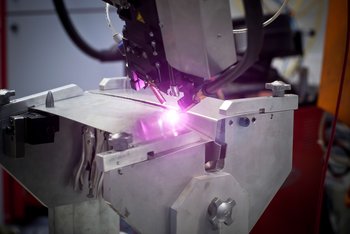Keyhole Welding
A major advantage of diode lasers is the calm molten pool that minimizes the amount of spatter on the workpiece and laser optic, which leads to smoother and cleaner welding seams.
To the examplesA major advantage of diode lasers is the calm molten pool that minimizes the amount of spatter on the workpiece and laser optic, which leads to smoother and cleaner welding seams.
To the examplesWith keyhole laser welding, very high beam intensities are used to process the material. Unlike heat conduction welding, here, a metal vapor is created in addition to the metal melt. This vapor partially displaces the melt, thereby leading to the creation of a vapor capillary (keyhole). This also applies for welding thick steel. The keyhole welding technique is characterized by a high process speed. The heat-affected zone is always highly limited, meaning that material distortion is correspondingly low. What remains is a narrow, evenly structured welding seam with a depth-gauge that is often bigger than its width.

A major advantage of Laserline’s diode lasers is the calm molten pool that minimizes the amount of metal splashes on the workpiece and laser optic, which leads to smoother and cleaner welding seams. With a protection class of IP54, the lasers guarantee process stability in tough application environments, even without protective enclosures. Their high electrical efficiency of up to 50 percent and their robust technology make Laserline’s systems a reliable, highly economical tool for keyhole welding. Designed for more than 30,000 operation hours, they are also very durable – and low maintenance, to boot.
Processes for welding sheets with thicknesses between 10 mm and 25 mm are becoming increasingly popular for different industrial applications. As far as the laser-based process goes, seam preparation currently poses a key challenge in this area. Variable gap dimensions are often unavoidable and must be bridged reliably and efficiently. With 50 kW laser power and spot sizes of up to 4 mm, Laserline’s LDF high-power diode lasers offer a suitable system solution for these applications, too.
Aluminum car body components used in visible areas require smooth and aesthetically appealing welding seams.
Here, Laserline’s diode lasers achieve excellent results, as the joints they create are uniform in shape and require no post-processing. The filler material of aluminum silicon (ALSi) is always required and serves to avoid hot cracks. It can be applied during the welding process with Laserline’s diode lasers in one of two ways: either via a tactile process optic or with the triple spot method using a supplementary wire, a method that was developed by Laserline. In this method, there are two side-spots positioned in front of the main spot, which first ablate the coating at the edge of the wire melting zone. This preparatory work results in a controlled melting process without the material being transferred to adjacent areas.
Over the course of three years, process investigations were conducted and diode laser requirements for aluminum welding were defined in close collaboration with Audi and other plant suppliers.
Which laser systems are particularly suitable for keyhole welding? Here you will find a selection.